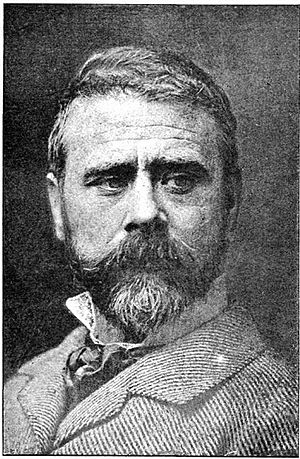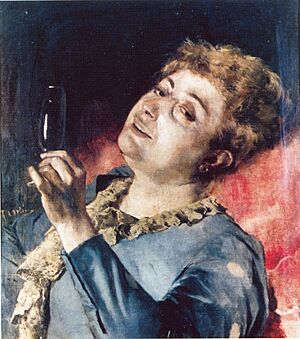Antonio Cortina Farinós facts for kids
Antonio Cortina Farinós (born February 16, 1841 – died November 6, 1890) was a talented Spanish painter, decorator, and art teacher. He was known for his beautiful paintings and for decorating churches and cafes.
Contents
Biography
Early Life and Artistic Beginnings
Antonio Cortina Farinós was born in Almàssera, a small town just north of Valencia, Spain. When he was a child, he helped his family by collecting manure for their farm. This led to his nickname, "El Femateret," which means "The Little Gardener."
While working, he often visited the art studio of a local sculptor named Rafael Alemany. It was there that Antonio first showed his amazing talent for art. Thanks to Alemany's help, Antonio began taking art classes at the Real Academia de Bellas Artes de San Carlos de Valencia when he was only ten years old.
Growing Recognition
Antonio quickly caught the eye of his professors. He had a habit of drawing funny cartoons on streets and walls using charcoal. Even though property owners didn't like the drawings on their walls, everyone could see his great talent. His artistic doodles even got an article written about them in the local newspaper!
In 1856, Antonio received a special scholarship of 3,000 Reales. This money allowed him to study art full-time at the Academia until 1862. Five years later, he won a Silver Medal at the "Exposición Regional de Valencia." He then won a Gold Medal at the "Exposición de Bellas Artes" in 1872, an art show held by the Ayuntamiento de Valencia (Valencia City Council).
Teaching and Decorating Work
In 1877, Antonio became an honorary member of the "Ateneo Científico, Artístico y Literario de Valencia." This was a respected group for science, art, and literature. In 1884, he was appointed as an assistant professor of line drawing at the Academia where he had once been a student.
Besides his painting, Antonio was also a skilled decorator. He designed fun rides for local festivals. He also created beautiful decorations for several cafes in both Spain and France. Many churches throughout the Valencian Community also feature his impressive murals, which are large paintings on walls or ceilings.
Later Life and Legacy
In January 1890, after Professor Rafael Berenguer y Condé passed away, Antonio Cortina became the Acting Professor of Line Drawing. He hoped to get this important teaching position permanently. Later that year, he traveled to Madrid as part of the application process.
Sadly, in early November, Antonio was found dead in his home on Calle de la Palma. His death was unexpected. After a memorial service, many of his artist friends held an auction. They sold some of their own artworks to raise money for Antonio's wife and children. In 1897, Antonio Cortina Farinós was laid to rest in the Pantheon at the Cementerio de Valencia.
See also
 In Spanish: Antonio Cortina Farinós para niños
In Spanish: Antonio Cortina Farinós para niños



